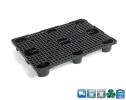By Falk B. (Schwerte, Deutchland) on 10 Apr. 2024 :
By CAN G. (LLERS, España) on 02 Apr. 2024 :
By Luigi D. (Ascoli Piceno, Italia) on 27 March 2024 :
By Maxime D. (Guidel, France) on 11 March 2024 :
By Kai K. (Eislingen, Deutchland) on 31 Jan. 2024 :
How plastic pallets are made ?
Published : 10/07/2017 06:06:51
Categories : Plastic Pallet

What is a Plastic Pallet made of ?
Originally the raw material comes from the industry that produces HDPE (High Density Polyethylene) aggregates. Directly from the production plants the pellets are called Virgin.
The plastics industry has already, for more than twenty years, organized the recycling circuits which also makes it possible to manufacture from recycled material.
Recycled plastic (HDPE) can come from bottles and caps of spring or mineral water or fruit juice.
Plastic granules can be neutral (transparent) or coloured to produce a wide range of colours on demand.
How are plastic pallets made?
Several manufacturing methods for plastic pallets:
- extrusion,
- high pressure injection moulding
- thermoforming.
The most widespread and qualitative method is high pressure injection moulding with a closing pressure of several thousand tons.
Plastic granulates are heated and softened to obtain a softer "paste". They are then automatically conveyed to high-pressure presses weighing several tons (minimum 3,000 tons).
The plastic pallet thus produced obtains, after a few minutes of cooling, its characteristics defined by the mould and the quantity of injected material.
The manufacture by injection in a mould makes it possible to produce a pallet in only one operation, it is known as monobloc.
The big advantage of a one-piece plastic pallet is the preservation of its dimensions.
Under normal conditions, it is not affected by changes in temperature or humidity, unlike other types of material.
Advantages and Applications of Plastic Pallets
The weight
Our plastic pallets are much lighter. Depending on similar characteristics, a plastic pallet can weigh up to three times less than its wooden equivalent.
Security
The recycled HDPE plastic pallet contains no screws, nails or splinters.
Naturally dry and not concerned by the ISPM15 standard, they are easily exported all over the world.
No risk of mould, wood blue stain or fungus.
Saving space
For nestable models, a storage gain of more than 50% compared to pallets that cannot be nested.
Hygiene & food Grade
In one-piece construction, the plastic pallet is non-porous and waterproof. It can be washed under high pressure and is resistant to detergents.
No more risk of falling wood in your warehouses, laboratories, clean rooms or even in your activities under food control, which guarantees a greater cleanliness.
Our "Special Protected Environments & Hygiene" model reinforces food safety qualities, particularly with its tray and completely smooth soles.
Esthetically
Plastics pallets accentuate the solidity, durability and cleanliness aspect.
Environment and End of Life
As for the packaging mentioned above, when the plastic pallet is unusable, it enters again into the recycling circuit to be incorporated in the manufacture of new plastic products, and why not a new pallet?

